Related Research Articles
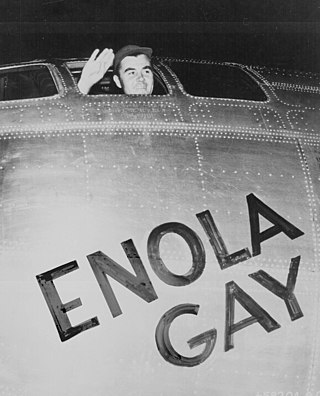
The Enola Gay is a Boeing B-29 Superfortress bomber, named after Enola Gay Tibbets, the mother of the pilot, Colonel Paul Tibbets. On 6 August 1945, during the final stages of World War II, it became the first aircraft to drop an atomic bomb in warfare. The bomb, code-named "Little Boy", was targeted at the city of Hiroshima, Japan, and destroyed about three-quarters of the city. Enola Gay participated in the second nuclear attack as the weather reconnaissance aircraft for the primary target of Kokura. Clouds and drifting smoke resulted in Nagasaki, a secondary target, being bombed instead.

The Manhattan Project was a research and development program undertaken during World War II to produce the first nuclear weapons. It was led by the United States in collaboration with the United Kingdom and Canada. From 1942 to 1946, the project was directed by Major General Leslie Groves of the U.S. Army Corps of Engineers. Nuclear physicist J. Robert Oppenheimer was the director of the Los Alamos Laboratory that designed the bombs. The Army program was designated the Manhattan District, as its first headquarters were in Manhattan; the name gradually superseded the official codename, Development of Substitute Materials, for the entire project. The project absorbed its earlier British counterpart, Tube Alloys. The Manhattan Project employed nearly 130,000 people at its peak and cost nearly US$2 billion, over 80 percent of which was for building and operating the plants that produced the fissile material. Research and production took place at more than 30 sites across the US, the UK, and Canada.
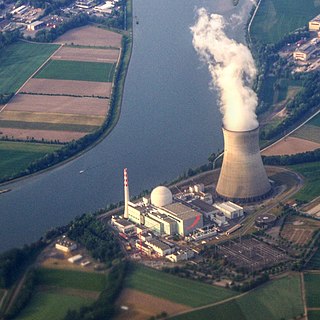
Nuclear power is the use of nuclear reactions to produce electricity. Nuclear power can be obtained from nuclear fission, nuclear decay and nuclear fusion reactions. Presently, the vast majority of electricity from nuclear power is produced by nuclear fission of uranium and plutonium in nuclear power plants. Nuclear decay processes are used in niche applications such as radioisotope thermoelectric generators in some space probes such as Voyager 2. Generating electricity from fusion power remains the focus of international research.

The United States Atomic Energy Commission (AEC) was an agency of the United States government established after World War II by the U.S. Congress to foster and control the peacetime development of atomic science and technology. President Harry S. Truman signed the McMahon/Atomic Energy Act on August 1, 1946, transferring the control of atomic energy from military to civilian hands, effective on January 1, 1947. This shift gave the members of the AEC complete control of the plants, laboratories, equipment, and personnel assembled during the war to produce the atomic bomb.
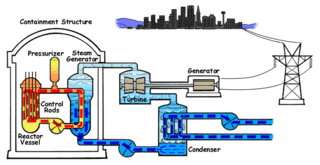
Nuclear propulsion includes a wide variety of propulsion methods that use some form of nuclear reaction as their primary power source. The idea of using nuclear material for propulsion dates back to the beginning of the 20th century. In 1903 it was hypothesized that radioactive material, radium, might be a suitable fuel for engines to propel cars, planes, and boats. H. G. Wells picked up this idea in his 1914 fiction work The World Set Free. Many aircraft carriers and submarines currently use uranium fueled nuclear reactors that can provide propulsion for long periods without refueling. There are also applications in the space sector with nuclear thermal and nuclear electric engines which could be more efficient than conventional rocket engines.

The Interim Committee was a secret high-level group created in May 1945 by United States Secretary of War, Henry L. Stimson at the urging of leaders of the Manhattan Project and with the approval of President Harry S. Truman to advise on matters pertaining to nuclear energy. Composed of prominent political, scientific and industrial figures, the Interim Committee had broad terms of reference which included advising the President on wartime controls and the release of information, and making recommendations on post-war controls and policies related to nuclear energy, including legislation. Its first duty was to advise on the manner in which nuclear weapons should be employed against Japan. Later, it advised on legislation for the control and regulation of nuclear energy. It was named "Interim" in anticipation of a permanent body that would later replace it after the war, where the development of nuclear technology would be placed firmly under civilian control. The Atomic Energy Commission was enacted in 1946 to serve this function.

The Atomic Energy Act of 1946 determined how the United States would control and manage the nuclear technology it had jointly developed with its World War II allies, the United Kingdom and Canada. Most significantly, the Act ruled that nuclear weapon development and nuclear power management would be under civilian, rather than military control, and established the United States Atomic Energy Commission for this purpose.
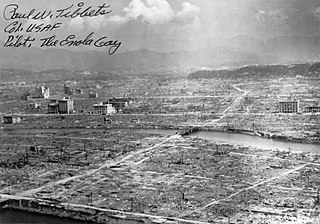
The nuclear weapons debate refers to the controversies surrounding the threat, use and stockpiling of nuclear weapons. Even before the first nuclear weapons had been developed, scientists involved with the Manhattan Project were divided over the use of the weapon. The only time nuclear weapons have been used in warfare was during the final stages of World War II when USAAF B-29 Superfortress bombers dropped atomic bombs on the Japanese cities of Hiroshima and Nagasaki in early August 1945. The role of the bombings in Japan's surrender and the U.S.'s ethical justification for them have been the subject of scholarly and popular debate for decades.
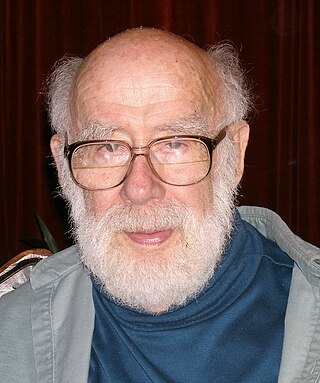
John William Gofman was an American scientist and advocate. He was Professor Emeritus of Molecular and Cell Biology at the University of California at Berkeley.

Naval Reactors (NR), which administers the Naval Nuclear Propulsion Program, is an umbrella term for the U.S. government office that has comprehensive responsibility for the safe and reliable operation of the United States Navy's nuclear reactors "from womb to tomb." A single entity, it has authority and reporting responsibilities within both the Naval Sea Systems Command and the National Nuclear Security Administration (NA-30). Moreover, the Director of Naval Reactors also serves as a special assistant to the Chief of Naval Operations for Naval Nuclear Propulsion.

The National Atomic Energy Commission is the Argentine government agency in charge of nuclear energy research and development.
In Pakistan, nuclear power is provided by six commercial nuclear power plants with a net capacity of 3,262 megawatts (3.262 GW) from pressurized water reactors. In 2020, Pakistan's nuclear power plants produced a total of 133 terawatt-hours of electricity, which accounted for roughly 10% of the nation's total electric energy generation.

The Samson Option is Israel's deterrence strategy of massive retaliation with nuclear weapons as a "last resort" against a country whose military has invaded and/or destroyed much of Israel. Commentators also have employed the term to refer to situations where non-nuclear, non-Israeli actors have threatened conventional weapons retaliation.

Kenneth David Nichols CBE was an officer in the United States Army, and a civil engineer who worked on the secret Manhattan Project, which developed the atomic bomb during World War II. He served as Deputy District Engineer to James C. Marshall, and from 13 August 1943 as the District Engineer of the Manhattan Engineer District. Nichols led both the uranium production facility at the Clinton Engineer Works at Oak Ridge, Tennessee, and the plutonium production facility at Hanford Engineer Works in Washington state.
Gilbert Ronald Bainbridge (1925–2003) was a British nuclear physicist, engineer and farmer.
The Forked River Nuclear Power Plant was a proposed nuclear power plant in Lacey Township in Ocean County, New Jersey. It was proposed as a single 1,070 MW reactor in 1969 to be built by Combustion Engineering and operated by Jersey Central Power and Light. The facility would have been located on a site between JCP&L's existing Oyster Creek Nuclear Generating Station and the Garden State Parkway. Unlike the Oyster Creek Plant, the Forked River Plant would have a cooling tower to prevent the release of hot water into Oyster Creek and Barnegat Bay.
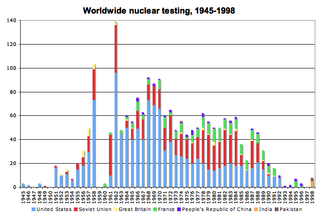
The application of nuclear technology, both as a source of energy and as an instrument of war, has been controversial.
The Zoé reactor, or EL-1, was the first French atomic reactor. It was built in 1947 at the Fort de Châtillon in Fontenay-aux-Roses, a suburb of Paris.
Marc W. Goldsmith is an American mechanical and nuclear engineer and consulting engineer, who served as 131st president of the American Society of Mechanical Engineers for the year 2012‐2013.
References
- ↑ Arthur W. Murphy. The Nuclear Power Controversy, 1976, p. 1.